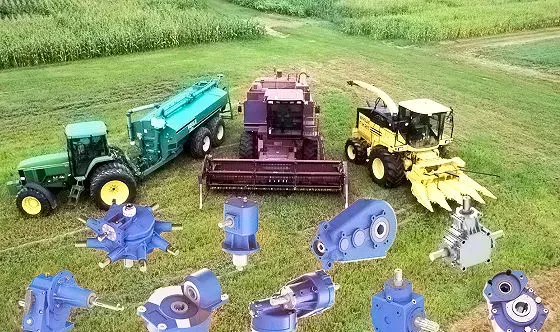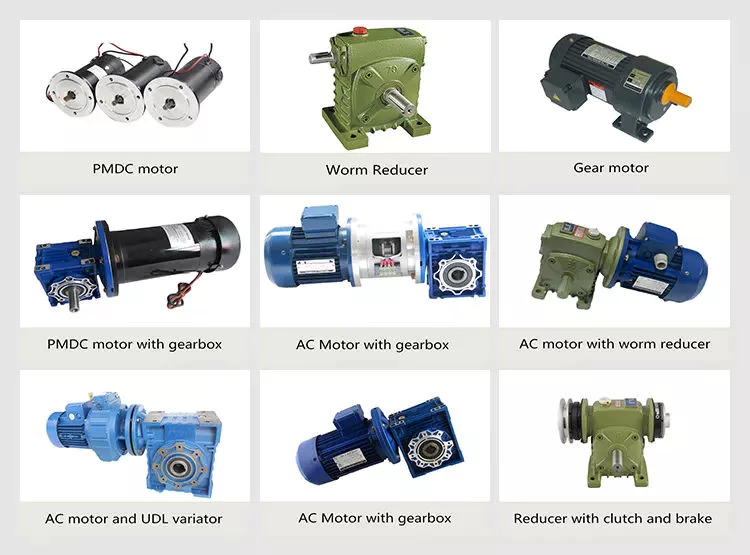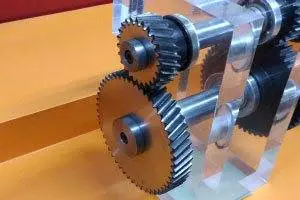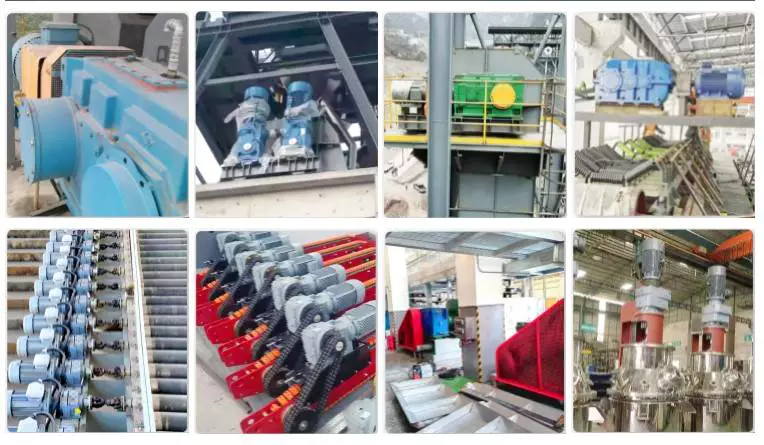Warranty: 1 year, 1 year
Applicable Industries: Building Material Shops, Manufacturing Plant, Machinery Repair Shops, Food & Beverage Factory, Farms, Energy & Mining
Weight (KG): 49 KG
Customized support: OEM
Gearing Arrangement: Helical
Output Torque: 90-550Nm
Input Speed: 1400rpm
Output Speed: 13-1379
Color: Blue(RAL5571)/Silver Grey (RAL9571)
Bearing: C&U/NSK
Application: Machine Tool
Ratio: 5.8-98
Heat treatment: Quenching
Gear material: 20 CrMnTi
shaft material: 45Cr
Housing material: HT250 High-strength Cast Iron
effciency: 92%~96%
Packaging Details: 1PCS in 1 wooden box
Port: ZheJiang or HangZhou
Gearbox Structure:
FeatureR series helical gear reducer is an advanced design concept introduced from abroad in recent years. It is developed and manufactured with reasonable structure, strong versatility, high reliability, low temperature rise, large bearing capacity and good combination performance in combination with the objective reality of our country. It can be combined with F series, K series, S series, etc. to obtain lower speed and greater torque.
| Product Name | R Series AC Motor helical transmission gearbox |
| Gear Material | 20CrMnTi |
| Case Material | HT250 |
| Shaft Material | 20CrMnTi |
| Gear Processing | Grinding finish by HOFLER Grinding Machines |
| Color | Customized |
| Noise Test | less than 65db |
| Efficiency | 94%~98% (depends on the transmission stage) |
| Lubricating oil | Shell Omala synthetic oil or mineral oil , or similar brand |
| Heat treatment | tempering, cementiting, quenching,etc. |
| Brand of bearings | C& Customized Steel Spline Shaft and Spline Shaft Coupling U bearing, ZWZ,LYC, HRB, OTHER,NSK and so on |
| Brand of oil seal | NAK or other brand |
| Temp. rise (MAX) | 40 ° |
| Temp. rise(Oil)(MAX) | 50 ° |
| Vibration | ≤20µm |
Gear motor size: R series RF series work shop Before spraying each reducer, air tightness test is needed to minimize the occurrence of oil leakage and air leakage. Ensure the long life and good operation of the reducer.
Packaging & Shipping
FAQ Q1: Are you a trading company or a manufacturer ?A: We are a manufacturer in ZheJiang Province, China. Our company owns the ability of manufacturing, processing, designing and R&D. We welcome your visit.Q2: How we select models and specifications?A: According to the specific details of the demands from the part of enquiry, we will recommend the products’ models CZPT synthesizing the factors of field of products usage, Motor Gearbox Reducer 400=12HP power, torque arm and ratio…Q3: How is your price? Can you offer any discount?A: Our prices are always competitive. If the customer can place a large order, we surely will allow discount.Q4: How long should I wait for the feedback after I send the enquiry?A4: We will reply as soon as possible, 12 hours at most.Q5: What is your product warranty period?A: We have the certifications of ISO9001,CE, SGS.Q6: What industries are your gearboxes being used?A: Our gearboxes are widely applied to metallurgical equipment, mining equipment, automation equipment, food machinery, packaging equipment, tobacco equipment and so on.
Our Services
1. Please check product detailed information above.
A. Model/Size
B. Power,voltage,output speed
C. Order Quantity.
2. Our Export Service Team will contact you with a quotation file within 3 hours after our team get your enquiry.
3. When you place an order, our team will confirm with you about color, package,method of payment and delivery,
then a sales contract will be sent to you to confirm.
4. Packing: Carton and Wooden Case.
5. How to delivery:
By sea – Buyer appoint forwarder, or our sales team find suitable forwarder for buyers.
By air – Buyer offer collect express account, Minimalism Good Lucky Lovely Natural Amazonite stone Abacus Beads Adjustable Bracelet For Couple or our sales team find suitable express for buyers. (Mostly for sample)
Others – We arrange to delivery goods to some place in China appoint by buyers.

The Different Types of Gearboxes
There are many different types of gearboxes. Some brands have more than one type. In this article, we’ll discuss the planetary gearbox, the worm reduction gearbox, the shaft mounted gearbox, and the one speed gearbox. This article will also help you determine which type of gearbox is best for your vehicle. And don’t worry if you don’t know the terminology yet. We’ll explain each type in detail so that you know what you’re getting yourself into.
Planetary gearbox
Planetary gears have many advantages. The multiple gears in a planetary gearbox mesh simultaneously during operation. As such, they provide high efficiency and transmit high transmittable torque. These gears are widely used in various industries and are resistant to high shock loads and demanding conditions. CZPT is one of the companies that offer planetary gearboxes. Its products do not require special tools for assembly, and its scalable design minimizes safety stock.
Among the numerous benefits of planetary gearing is its compactness and lightweight. As such, it is suitable for wide applications with space and weight constraints. However, to truly appreciate its benefits, it is necessary to understand its mechanisms. Here are some of the most common details about planetary gearing:
The planetary gearbox has two mounted gears: an input shaft and an output shaft. Each gear has multiple teeth that are attached to a carrier and rotate with the input shaft. The carrier is connected to the output shaft. A planetary gear is mounted on both gears via a carrier. The carrier rotates in order to drive the planetary gear. The sun gear is often the input gear. The other gear is called the outer gear.
Planetary gearboxes are highly customizable. The size, mounting, and housing options vary, as do the reduction ratios and input speeds. Different types can be manufactured for different applications and include options such as electrical or mechanical preload. The final design of a planetary gearbox can be highly customized, based on the specifications of the application. By combining engineering excellence and ongoing innovation, planetary gearboxes provide years of trouble-free operation.
A planetary gearbox can be either an electric motor or a manual one. The latter has more features than the former, and can be used in applications where space is an issue. The primary features of a planetary gearbox include its backlash, torque, and ratio. Secondary features include noise, corrosion resistance, and construction. A planetary gearbox is a highly versatile gearbox that can drive anything from simple machinery to advanced electrical systems.
Worm reduction gearbox
The global worm reduction gearbox market report compiles key insights from the industry to help you improve your business strategy. This report will help you create a comprehensive business document that will enhance your company’s competitive edge. To obtain this report, visit our website now! Read our latest report to find out what you can expect from the global worm reduction gearbox market. Alternatively, request a sample copy for more details. Here is a sneak peek of the report:
Worm gears are made with different thread counts and are usually not matched with the CZPT standard. In general, a single thread worm should be used with a single thread worm. Worm gears have either right or left threads, and their thread count will be different as well. This type of gear is used to reduce the speed of a rotating shaft. The speed reduction ratio will be about 50 percent if the worms have the same thread count as the CZPT gears.
The standard gear set transfers power at the peak load point of a tooth, called the pitchline. The worm gear moves slowly against the wheel’s metal surface. The worm gear is also more complex than the standard gear because the worm is sliding rather than rolling. Worm gears are hard to lubricate. Moreover, the sliding contact between the gear and worm increases the complexity of the gear set. They can be a great solution for applications where noise is a significant factor.
The axial pitch and circular pitch of the worm are equal. The ratio of these two indices determines the speed of transmission. For a worm reduction gearbox to work, the axial pitch and the circular pitch must match. The pitch angle of a worm can either be left-handed or right-handed. The lead of a worm is the distance one thread travels in one revolution. The lead angle is the angle tangent to the thread helix of the cylinder’s pitch. When a worm mesh is reversed, the majority of the mesh will be on the receding arc.
Worm gears generate more heat than their counterparts, so it is important to choose a worm reduction gearbox carefully. You will want to choose the material and amount of lubricating oil carefully. Worm gears are generally made of tin bronze. The paired worms are hardened to HRC45-55. In general, they are durable, lasting up to ten years. But they will wear out – and they wear out – so you may want to consider some other factors.
Shaft-mounted gearbox
Shaft-mounted gearboxes are designed for a variety of mining and quarry applications. Their high reliability and low maintenance make them an excellent choice in these types of applications. Shaft-mounted gearboxes also feature an optional backstop device that prevents the unit from rotating in one direction. This makes them an excellent choice for applications where alignment accuracy is an issue. Here are some of the benefits of using a shaft-mounted gearbox:
Shaft-mounted gearboxes are typically constructed of aluminium, and come in sizes ranging from 050 to 125. They feature a variety of reduction ratios and ensure optimum efficiency in all operating conditions. New S series sizes, 140 and 150, extend the application range of shaft-mounted gearmotors. They are both backed by a two-year warranty. For even greater peace of mind, Shaft-mounted gearboxes are available with a range of warranty options.
The most common applications for a Shaft-mounted gearbox include traction-driven applications where a low-speed shaft is required for operation. They also are suitable for applications without a foundation, where the motor is mounted next to the reducer. To prevent the gear drive from rotating, a torque arm is attached between the motor and the shaft. Small-sized shaft-mounted gear drives are usually made without motor mount kits, which can make them an excellent choice for conveying light loads.
Another important feature of a Shaft-mounted gearbox is its mounting position. The reduced motion through the drive is redirected through the shaft, creating additional forces. These additional forces can affect the performance of the gearbox, causing vibrations and noise. Consequently, it is important to replace worn or damaged belts on a regular basis. Further, shaft-mounted gearboxes can be affected by problems with other components and amplify vibrations.
1 speed gearbox
CZPT Group Components produces one speed gearboxes. These transmissions are produced in the CZPT Group’s Kassel plant. They are compact and robust, and are designed for easy integration. The Bosch Rexroth GD1 one-speed gearbox is easy to install horizontally or vertically. The Plug and Drive system integrates the gearbox with the existing cooling system. There are many other benefits to this gearbox.
With an ID.3 electric drive motor, the maximum torque is delivered at 16,000 rpm. This single-speed transmission offers high power density and excellent noise-reduction, making it ideal for electric vehicles. The e-drive motor is extremely quiet and requires precision manufacturing. The e-drive motor also enables a wide range of driving conditions. It can reverse when needed, and reaches its maximum speed at 16,000.
The single-speed gearbox is a standard feature on most electric vehicles. Some electric vehicles, such as the Porsche Taycan, will be equipped with a two-speed gearbox. This gearbox offers more top speed and range, but it is more complex than a standard single-speed gearbox. CZPT doesn’t need to add complexity to its electric vehicles. After all, a 355 horsepower family wagon is not likely to need a dual-speed gearbox.
In addition to simplifying the transmission, the patent claims also address improvements in structural design. Fig. 5 shows a schematic representation of a transmission 50′, wherein gear sets Z1 and Z4 are exchanged between partial transmissions. This switch matrix also reflects the synchronized gears and lastshelf gears. Hydraulically betatigte Lamellenkupplungen (HBA) also form a last-shelf gear.
Another advantage of the patent claim is that it offers numerous functional freedoms, which is especially valuable in the design of an automobile. One of the patent claims identifies a tosatzlicher middle gear that allows a driver to switch between second and third gears, with a single gearbox. In a conventional one-speed transmission, the tosatzlicher middle gear is attached to the second and first part gearbox. The latter has a second and third gear.


editor by Cx 2023-07-11



















